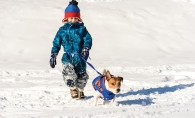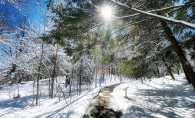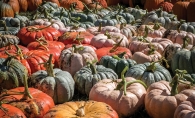Children are spending half as much time outside as they did 20 years ago, according to recent studies. From weather issues to safety concerns to increased screen time, there are a variety of reasons for the shift, says Laura Duffey, school forest specialist for the Minnesota Department of Natural Resources. Together with the DNR, she’s working to get kids outside.
Duffey is a passionate advocate for creating playgrounds with natural materials including rocks, logs and sticks. “When you look at playground equipment, how many things can you do with a slide? ... If you bring in a few logs, they cost nothing and there’s a multitude of ways [kids can play with them],” says Duffey. “The play value is going on because the kids don’t get bored with the logs.”
Emily Ball, the city forester for Minnetonka, believes children are naturally curious and interested in nature. Parents just need to open the door. “It’s not saying ‘Oh, that’s gross’ or ‘Oh, you’re dirty,’ ” says Ball. “We all have washing machines.”
Ball recommends building a natural play area in your yard or visiting a local park. “We don’t have just parks with maintained play structures [in Minnetonka],” says Ball. “We have a lot of open space and natural areas we’re working on restoring."
For a list of 25 ways to get kids outside, visit lakeminnetonkamag.com or visit the Nature Adventure Play Area at the 2014 Eco Experience at the Minnesota State Fair from August 21 to September 1.
25 Ways to Get Kids Outside to Play
Courtesy of the Minnesota Department of Natural Resources
- Open the door: Regularly encourage outdoor play in all safe weather conditions.
- Water: Provide water from a hose, faucet, sprinkler, rotating sprayer, rain barrel, hand pump or spray bottles.
- Water transport: Part of the fun of water play is moving water around. Use watering cans, buckets, hollow bamboo poles, plastic pipes, pots and pans, recycled milk jugs and more.
- Digging pit: Create an area for your kids to dig down with kid-sized shovels. Have boots handy when it rains and the dirt turns to mud!
- Dirt pile: Build a dirt pile. The larger the pile, the more fun and creative play your kids will have.
- Leaf pile: Rake fallen leaves into giant piles with your kids and let them have at ’em! The good memories will last longer than the leaves.
- Sand: And lots of it! Contain it with shrubs, landscape timbers, old tires used as planters, boardwalks, etc. Add water for some great artistic play.
- Plants: Lots of Plants! Everywhere!: Grow plants in beds, giant pots, window boxes, old tires and vining up trellises and trees. Let your kids plant and care for them.
- Vegetable garden: Grow vegetables with your kids. Choose veggies that will ripen at different times during the growing season. Use planting beds, giant pots or a fenced in garden.
- Pumpkin patch: Pumpkins are so special they merit their own category. They’re easy to grow and can help celebrate the fall season (hello, jack-o-lanterns).
- Butterfly garden: Plant a selection of insect-attracting flowers, both annuals and perennials. Consult your local garden center or the Internet for help.
- Milkweed and monarchs: Milkweed attracts monarch butterfly caterpillars, since it’s the only thing they eat. Your kids can collect them, place in a screened box and supply with fresh milkweed leaves until they become enclosed in a cocoon (usually less than a week).
- Logs: Lay one or more large logs on the ground for balancing, sitting and hiding. Stake them in place or partially bury them so they can’t roll unexpectedly.
- Rough ground: Set aside part of your backyard where your kids can dig, build, hide and plant. Write a simple lease that gives them ownership of the spot and hold a “signing ceremony” to make it official.
- Trees to climb: Kids have always climbed trees. If you have a strong, spreading tree, hang a rope ladder from its lowest limb so your kids can climb. Deep mulch at the base will help cushion any slips.
- Shrubs: They grow faster than trees and appear to be giant in kids’ eyes. Plant them in groups to create nooks and niches or in a row along a narrow pathway to create a maze.
- Rocks and boulders: Let your kids build with rocks that are small enough to carry around, but too large to throw. Be sure to choose their permanent locations in advance.
- Play stream: Create a small, inches-deep stream that flows only when you turn on the hose. Dig a very shallow, sloping streambed and fit it with a heavy pond liner. Cover with gravel and larger cobblestones that kids can use to create dams and channels with water from a hose.
- Seating: Place benches, bench swings, kid-sized Adirondack chairs, hammocks, hammock chairs, rockers, boulders, stumps and logs in shady spots in your back yard. Encourage your kids to sit, talk with friends and look at books, daydream and rest.
- Hills and berms: Children love small, grassy hills that they can roll down, charge up, sled on, hide behind or use to play “king of the mountain.” Plant them with tough turf grass and keep them clear for uninhibited play.
- Adventure paths: Create very narrow, meandering routes through tall grass, between boulders or that simply connect two activity areas. If the path leads to a secret nook, it’s all the better.
- Discovery board: Lay a piece of scrap 2-foot-square plywood on the ground in a quiet, leafy corner of your play area and see what bugs, ants, slugs and other mini-beasts move in underneath it.
- Materials for outdoor construction play: Use small logs, large wooden blocks, boards, branches, sticks, milk crates, blankets and more for your kids to create an outdoor structure.
- Tools and toys: Provide a variety of tools and toys to help your kids explore and play with nature—insect nets, bug houses, magnifiers, binoculars, scoops, colanders, etc.
- Birdhouses: Kids like to watch nest-building activity, and then see and hear what happens inside. Provide a birdhouse so your kids can listen and watch for baby birds.









